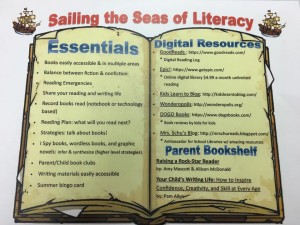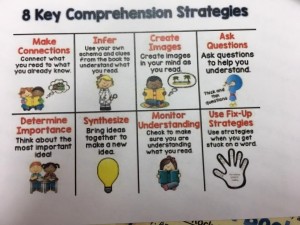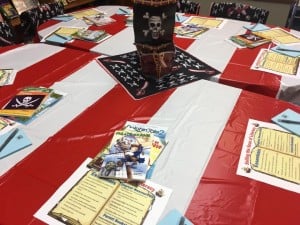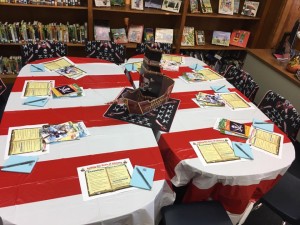A key goal of any school should be to promote an environment that promotes lifelong literacy. I am not talking about just on paper or in an SIP plan and not just through the delivery of the reading curriculum to meet the standards, but in a way that deepens a love of reading and enhances a child’s life as a reader. I firmly believe that educational leaders must be readers. Readers are leaders. This models the importance of literacy for staff, students and parents. Continuous reading (writing and reflecting) refines practices, provides a basis for continuous improvements, and fosters lifelong learning habits that can be instilled in staff and students. Not only do I talk books, but I share them in my weekly memos to staff, as recommendations to parents and staff, and with our students. Rewards and incentives for reading are… you guessed it… books! Books are available readily to students in the hallways, classrooms and library. If students come into the office when they aren’t feeling well, are waiting for a parent, or need to make a phone call, there is a basket of books just waiting to be picked up and read. As students wait in the foyer to be picked up after school, there are shelves of books filled and available to students. No strings attached!
But having books accessible to students is just one part of the greater picture. Teachers need to have the professional knowledge and capacity in addition to the relationships and rapport with students to match the correct text with the right reader. “There are no such things as students that don’t like to read. There are just kids that haven’t found a book that is right for them.” Knowing a child’s reading level, personal interests, stamina for reading, and preferred genres can help teachers create a love of reading. That being said, there are so many books available, that it takes time and energy to sift through all the options to find that one right fit book for each child.
A key school goal of Dunlap Grade is “To create a culture of readers.” If you are at DGS, you hear and see this often. This is quantified like any SIP plan with data and statistics, but it is also woven into the fabric of our school composite. We monitor our progress through assessment, charts, graphs, and in PLC meetings, but we also do something simple. We talk about books. We share our reading lives with our students. We share book recommendations with each other. We put books in the hands of our students in numerous ways.
So, when our regularly scheduled staff meeting approached, it came as no surprise that the focus would be on literacy (although it does rotate with other key curricular areas). Knowing that the staff is versed in reviewing data and making instructional decisions about that data, I wanted to build their capacity as reading teachers in the simplest and purest form: to build their knowledge of books that have touched the lives and hearts of their colleagues and in the classrooms in our school. Born was “Book Bingo.”
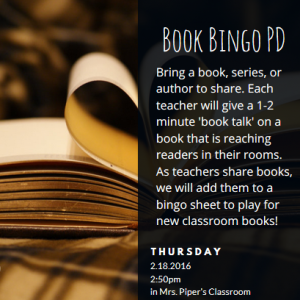
Staff was asked to bring a title, series or author to share with their colleagues at the staff meeting. They came prepared with the book and a short 1-2 minute summary of the book and why they chose it. In a short period of time, staff built their repertoire of book titles to add to their classroom libraries as resources or read alouds. As staff shared their books, they were recorded on a white board and individual teachers wrote the titles at random on a blank bingo board. As teachers talked about their books they asked questions, made text-to-text connections, and grew their knowledge of titles and genres that they could refer to to recommend to another child, teacher or parent. Books that were discussed included graphic novels, series, award-winning picture books, humorous read-alouds, books that promote empathy, titles that dug into deeper emotional concepts, and more. Several times I heard, “That reminds of another great title…” or “You should read this book…” or “Can I borrow that in my classroom…” and “I need to add that to my personal reading list.”
As titles were discussed and teachers filled their bingo boards, we then finished with a quick game of bingo, calling the names of books that had been discussed. The beauty was that all teachers were winners and were able to select new titles of books for their classroom libraries as they left the meeting thanks to donations from individual parents and our Parent’s Club Organization. There’s no happier words a principal can hear than “I love getting new books for my classroom!” from a teacher.
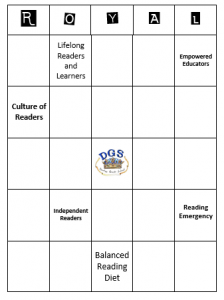
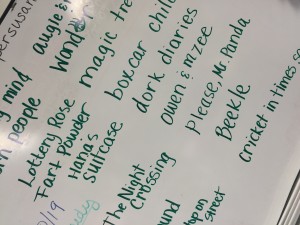
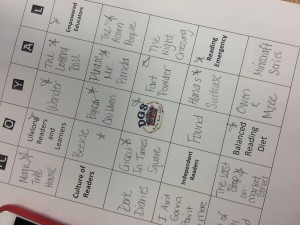
book bingo
book bingo
Professional development does not need to be overthought, but it does need to be strategic and meaningful. A balanced approach to the emotional and academic domains of teaching and learning reading need to be considered and attended to. Teachers need to have the time to share effective and meaningful books in order to truly promote a love of reading in their classrooms and among students.
You can read more about promoting a love of literacy at:
https://nerdybookclub.wordpress.com/2015/12/04/how-does-a-principal-foster-a-love-of-reading-in-her-own-children-by-mandy-ellis/
https://dunlapgradeschool.edublogs.org/2016/01/04/reading-resolutions-2016/
https://dunlapgradeschool.edublogs.org/2015/10/06/dgs-literacy-harvest/
 Dunlap Grade School hosted its first “Lunch in Learn” of the series on November 16, 2016. The topic of the month was focused on literacy and fostering a love of reading at home. 2nd Grade Teacher, Mrs. Pitzer, facilitated a parent discussion on essentials of reading, ideas, and resources. This event was intended to engage parents in a learning opportunity to extend teaching practices in the home. In addition to the resources shared, parents were given copies of several books to support reading at home! You can view the Facebook LIVE Video HERE
Dunlap Grade School hosted its first “Lunch in Learn” of the series on November 16, 2016. The topic of the month was focused on literacy and fostering a love of reading at home. 2nd Grade Teacher, Mrs. Pitzer, facilitated a parent discussion on essentials of reading, ideas, and resources. This event was intended to engage parents in a learning opportunity to extend teaching practices in the home. In addition to the resources shared, parents were given copies of several books to support reading at home! You can view the Facebook LIVE Video HERE
